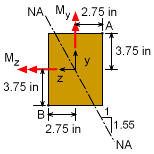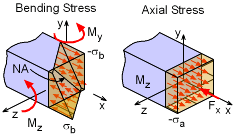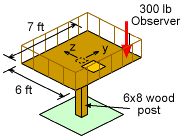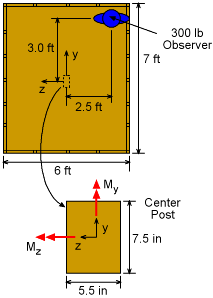| Ch 6. Advanced Beams | Multimedia Engineering Mechanics | ||||||
|
Composite Beams |
Unsymmetric Bending |
||||||
| Unsymmetric Bending | Case Intro | Theory | Case Solution | Example |
| Chapter |
| 1. Stress/Strain |
| 2. Torsion |
| 3. Beam Shr/Moment |
| 4. Beam Stresses |
| 5. Beam Deflections |
| 6. Beam-Advanced |
| 7. Stress Analysis |
| 8. Strain Analysis |
| 9. Columns |
| Appendix |
| Basic Math |
| Units |
| Basic Mechanics Eqs |
| Sections |
| Material Properties |
| Structural Shapes |
| Beam Equations |
| eBooks |
| Dynamics |
| Fluids |
| Math |
| Mechanics |
| Statics |
| Thermodynamics |
| ©Kurt Gramoll |
|
|
||
|
|
A 6 ft by 7 ft observation platform is supported by a single 6x8 wood post. The maximum weight of the observer is 300 lb. It is assumed that the observer can stand within 6 inches of the railing in any corner. If the observer stands in one of the four corners, the distance from the post center will be 3 ft and 2.5 ft. The observer weight will cause a bending moment about both the y and z axis that are in the plane of the platform, as shown in the diagram. This results in unsymmetric bending stress. The observer weight also causes a direct axial compression force on the post that is in addition to the bending moments. |
|
|
|
Bending Moment |
|
|
The unsymmetric bending moment is best determined by calculating the moment about the y and z axis separately. These moments are My = (2.5 ft)(12 in/1ft)(300 lb) = 9,000 in-lb Mz = (3 ft)(12 in/1 ft)(300 lb) = 10,800 in-lb Both moments are positive since they generate a moment vector that points along both positive axes. The right-hand rule is helpful in determining the moment vector direction where the fingers rotate around the axes in the rotation direction of the moment and the thumb points in the direction of the moment vector. |
||
| Moment of Inertia |
||
|
The moment of inertia needs to be calculated for the member cross section. The exact dimensions of the 6x8 wood member is 5.5 in by 7.5 in (See Structure Shapes appendix). Iy = (5.5 in)3 (7.5 in) / 12 = 104.0 in4 Iz = (7.5 in)3 (5.5 in) / 12 = 193.4 in4 |
||
| Neutral Axis (NA) |
||
 Neutral Axis Location |
To help locate the point where the bending stress is maximum, it is useful to plot the NA. This is done by setting the unsymmetric bending stress equation equal to zero. 0 = My z / Iy - Mz y / Iz 0 = 9,000 z / 104.0 - 10,800 y / 193.4 y/z =86.54/55.84 = 1.550 This line is plotted in the diagram at the left. Notice, the furthest perpendicular point from the NA is either point A or B. Point A will give the highest compression stress where point B will give the highest tension stress. |
|
| Bending Stress |
||
|
The unsymmetric bending stress can be calculated from the equation, Point A (diagram above) is one of two points that are the furthest away from the neutral axis which will give the largest bending stress. The location of point A is y = 3.75 in, and z = -2.75 in, which gives σb = 9,000 (-2.75) / 104.0 - 10,800 (3.75) / 193.4 = - 238.0 - 209.4 psi = - 447.4 psi The negative sign indicates a compression stress. |
||
| Normal Axial Compression Stress |
||
 Bending and Axial Stress Distribution |
In addition to the bending stress, there is an axial stress caused by the vertical weight of the observer. This stress is σa = P / A = -300 lb / (5.5 in)(7.5 in) = -7.273 psi This stress is significantly lower than the bending stress and could be ignored, but it is always good to check. The total compression stress is σ = σb + σa = - 447.4 - 7.3 = - 454.7 psi |
|
Practice Homework and Test problems now available in the 'Eng Mechanics' mobile app
Includes over 500 free problems with complete detailed solutions.
Available at the Google Play Store and Apple App Store.

